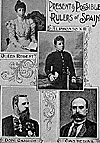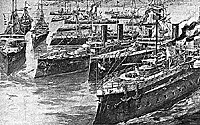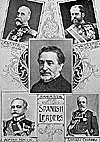A kingdom of Europe occupying the greater portion of the Iberian Peninsula and reaching farther south than any other country of Europe, and farther west than any other but Portugal. Its greatest length from north to south is 560 miles, from east to west 650 miles, the average width about 380. Including the Balearic and Canary Isles, its area is 195,738 square miles; its population in 1887, its last official census, was 17,673,838. It increases in population very slowly. from '77 to '87 the gain was 4.7 per cent. For the decade preceding '77, the gain was 3.5 per cent.
In 1890 the United States, exclusive of Indian Territory and Alaska, had an area of 2,939,000 square miles, with a population of over 60,000,000, a gain in population of 24.9 percent since 1880.
Cities
Spain's largest city, Madrid, has a population about equal to that of Boston.
The principal Meditcrranean ports are: Barcelona, population 272,000; Malaga 134,000; Cartagena, 84,000. Atlantic ports: Cadiz, 63,000, and Ferrol, 22,000. Biscayan ports: Bilbao, 50,000, and Santander, 31,000. All these are fortified. Ferrol has one of the best harbors in Europe. The entrance is narrow and might be well defended. Spain has here a large arsenal and a good ship-building plant. Corunna, twelve miles southwest of Ferrol, has also a good harbor well fortified and has some government ship-yards.
Surface
The surface of Spain is more varied than that of any other country of Europe of the same size. There are several distinct mountainous ranges, between which flow the great rivers Duro, Tagus, Guadiana and Guadalquivir. The central region, comprising about one-half the whole area, is a great plateau. having, an average elevation of almost 2,300 feet. The rivers are navigable only for small boats near their mouths. Spain has 1,400 miles of coast line, which is little indented except on the northwest, where it is bold and rocky.
Climate and Soil
The climate varies with the configuration of the country. Madrid is said to have experienced weather so severe that sentinels on duty were frozen to death. The soil is generally fertile, and 80 per cent of it is classed as productive. Wheat, rye, barley, corn, olives, grapes and oranges are the principal agricultural products. Spain is rich in minerals. Iron is abundant. In 1895 its mineral exports; were valued at thirty-four millions of dollars, the chief of which were iron, copper, zinc phosphorus, coal and salt.
Religion
The Constitution enacts: "The nation binds itself to maintain the worship and ministers of the Roman Catholic religion." Nearly the whole population are Roman Catholic. In 1888, there were 6,654 Protestants and 400 Jews. By the Constitution of 1876 a restricted liberty of worship in private is allowed Protestants, but all public announcements of such services are forbidden.
In 1894 there were 32,435 priests, 1,684 monks, 14,592 nuns. There were 65 cathedrals, 30 religious colleges, 18,564 churches, and 11,202 other buildings of a religous character.
Education
By the law of 1857 there was to be a primary school for every five hundred inhabitants, and compulsory education was to be rigidly enforced. The theory did not materialize. The average teacher's wages ranges from fifty to one hundred dollars per year; and of the population, 68.1 per cent can neither read nor write; 3.4 per cent can read but not write; and only 28.5 per cent can read and write. There are about two males to one female of those who can read and write. The entire sum spent for education in 1887 was less than $400,000.
Finance
The bank of Spain is the great financial institution of the country. It was organized in 1874 and possesses the exclusive right to issue circulating notes. The limit of issue was originally $150,000,000 but in 1891 this limit was doubled. Ostensibly the Bank is required to keep a reserve of 1/3 of the circulation, with 1/2 of that being gold. The actual outstanding circulation in 1890 was $46,800,000 and the notes were then at a slight discount in gold, and with the continuing increase in the issue of notes which has been going on the premium on gold is now 50%.
The fact is that the bank has not for a long time paid for its notes. It professes to redeem them in silver, but the fall of the price of silver has made the gold value of the bullion in the silver coin of less value than the gold value of the bank notes of the same denomination. The stock of gold in the Bank is simply held and is of no particular service as circulation, although it may be drawn on in the emergencies of war. The circulation has steadily increased as the Government has made demands on the Bank until last April the limit of $300,000,000 had nearly been reached.
The Bank makes advances to the Government on the security of bonds and treasury notes. Therefore, as the Government has now unlimited power to make loans and lay taxes there seems to be no limit to the extent to which the issues of the Bank of Spain may be extended in support of the war. No doubt they will continue to depreciate from the gold par and will very soon be worthless than the silver coin, but when the nation becomes aroused and determined paper money beomes merely a means of bringing into action all the material strength of the country. It is really a forced loan levied upon the whole prooperty of the nation regardless of individual rights and of everything except for the object of preserving the life of the nation. The assignats of France, the paper money of the Confederate States, the Continental money of the American Revolution, all served the purpose, and finally remained valueless in the hands of the last holders. The legal-tender notes of thc Civil War did not depreciate to this extent, but at one time they progressed far in this direction and the losses to inclivicluals through their fluctuations never were and never can be adjusted.
It is well, not to count too much on the inability of Spain to carry on war on account of financial weakness. There may be other reasons why she may fail to make headway against this country, but it will not be wholly from lack of money [Bankers Magazine, June 1898].
Spain's total debt in 1897 was $1,709,806,331.64, the interest on which was $67,584,525.80. About one-half her debt was held in France, and for $400,000,000 of it the revenues and monopolies of Cuba are pledged as collateral security. This will very naturally make the owners of such bonds much averse to losing their collateral. Just before the Maine disaster, Spanish 4 per cent bonds sold for 62 1/2 in London. When the American fleet appeared off Havana they had fallen to 30 1/2. At that rate, if she wished to float a bond at par, it would be necessary for it to bear 13 per cent interest. The United States bond bearing 4 per cent interest is selling to-day for 121. On thc receipt of the news of the American victory at Manila, gold went to a premium of 111 in Madrid; or, in other words, a dollar of her paper currency was worth about 47 cents.
The revenues of the Spanish Government are raised by direct and indirect taxes, stamp duties, income from governmcnt property and from various government monopolies.
Direct taxes are levied on real estate, certain industries, commerce, titles of nobility, mortgages and certain products of the mines.
Indirect taxes are levied on imports, specified articles of commerce, and tolls on roads, bridges, canals, etc.
Her revenue in 1897 was $212,983,527.92 and the expenditure about as much. To-day her expenditures have greatly increased and now exceed her income, and ruin or repudiation of her debt stares her in the face. Repudiation is nothing new to her, as she repudiated no longer ago than the '70s. The unit of currency is the peseta divided into 100 centesimos.
In 1895, the total exports of Spain were 686,700,802 pesetas and the imports were 660,875,994 pesetas, France and Great Britain getting the lion's share of the trade.
1898 US Dept. of Agriculture Bulletin (Spanish Trade/Commerce Information)
Government
 Spain has a written Constitution consisting of 89 articles articles, established in 1876. It specifies that Spain shall be a constitutional monarchy, leaves the execution of the laws resting with the king and vests the power to make laws "in the Cortes with the king."
Spain has a written Constitution consisting of 89 articles articles, established in 1876. It specifies that Spain shall be a constitutional monarchy, leaves the execution of the laws resting with the king and vests the power to make laws "in the Cortes with the king."
Spanish Rulers Large Photo (slow: 127K)
Cortes
The Spanish Cortes is composed of a senate and a congresss, equal in power. Of the senators there are three classes.
- First: Senators by their own right. To this class belong sons of the king, if any, and of the next heir to the throne who is of age; grandees in their own right who have an annual income of $12,000; captain-generals of the army; admirals of the navy the the Patriarch of the Indies, and the archbishops, the presidents of Council of State, of the Supreme Tribunal; and of the Supreme Council of War and of Navy, after they have held office two years.
Second: This class comprises life senators appointed by the crown. As a safeguard the senators of the first and second classes must never exceed in number the senators of the elected class.
Third: This class consists of 180 senators elected by corporations and the highest taxpayers. Of the elected senators 1/2 must be chosen every 5 years, and all of them whenever the monarch dissolves that part of the Cortes.
Congress
Congress consists of 432 members elected for five years and in the proportion of about one to every 50,000 population. The right of franchise is held by all male Spaniards 25 years of age who enjoy full civil rights and have been citizens of the district for at least two years. Members of congress, unless they belong to the cabinet, cannot hold state office nor receive salaries or pensions. Congress and the senate must meet each year.
The monarch has the power of convoking, suspending or dissolving the Cortes, but if dissolved, a new one must meet within three months. The monarch appoints the president and vice-president of the senate, from members of the senate. Congress chooses its own officers and has the power of impeaching ministers before the senate. The monarch cannot marry without the approval of the Cortes; nor marry anyone excluded by law from succession to the throne.
Ministry
The Spanish Ministry corresponds to the English and American Cabinet. The monarch is inviolable, but his ministers are responsible for all acts that offend the people, and are frequently punished. All decrees of the king must be signed by one of the ministers.
Army and Navy
All Spaniards over 19 years of age may be required to serve 3 years in the active army, 3 years in the first reserve, and 6 years in the second reserve, but may purchase exemption from service for about $300. Spain has 13 military schools and colleges. Spain claims to be able to mobilize an army of more than one million in case of necessity.
 Spain has a fairly powerful navy consisting of one first-class battleship, eight splendid armored cruisers, andother vessals we shall describe in detail. The navy is manned by about 1,000 officers, 800 machinists, 14,000 sailors and 900 marines. The recruits for the army and navy are secured by conscription.
Spain has a fairly powerful navy consisting of one first-class battleship, eight splendid armored cruisers, andother vessals we shall describe in detail. The navy is manned by about 1,000 officers, 800 machinists, 14,000 sailors and 900 marines. The recruits for the army and navy are secured by conscription.
Pre-War Spanish Fleet Large Drawing (slow: 136K)
Pre-War Spanish Fleet Jumbo Drawing (extremely slow: 352K)
The individual courage of the men ranks high, but Spanish officers throughout their whole history have shown marvelous capacity for doing the wrong thing at the wrong time. They are wretched engineers and depend almost wholly on the Scots and French to fill these positions. Their gunnery does not enjoy a high reputation for accuracy, and the poverty of their resources has prevented target practice.
War Strength: In March 1896, exclusive of the 56 line battalions and 10 rifle battalions then in Cuba, there were available for mobilization in the Peninsula, including the garrisons of the Balearic and Canary Islands, and of North Africa:
- Infantry: 56 second battalions at 1,000, 56,000 men; 56 third
battalions at 1,000, 56,000 men, 10 rifle battalions at 1,200, 12,000 men.
Cavalry: 28 regiments at 596 horses and 700 men, 19,600 men.
Artillery: 14 field artillery regiments, each of 8 bateries of 6 guns, with an equal number of artillery and infantry ammunition columns, 25,606 men; 3 mountain artillery regiments and ammunition columns, 7,254 men; 9 battalions fortress artillery, partly of 6, partly of 4 companies, 8,175 men.
Engineers: 4 sapper and miner regiments at 2,000, 8,000 men; 1 pontoon regiment, 3,442 men; 1 railway regiment, 1,040 men; 1 telegraph battalion, 1,272 men.
Total: 196,389 men.
Reserves
The following reserve troops were also available:
- Infantry: 112 reserve battalions (56 regiments of 3 battalions)
at 1,000 men, 112,000 men.
Cavalry: 14 reserve regiments of 4 squadrons, with 600 horses and 702 men, 9,828 men.
Artillery: 7 field artillery regiments, 1 for each army corps district, and 136 guns, 14,140.
Engineers: New formations, 6,000 men;
Total: 141,968 men.
Apart, therefore, from the troops in Cuba, 130,000 men in round numbers, there were in March, 1896, available on mobilization, 340,000 men, with 25,108 horses (cavalry) and 952 guns.
Military Schools
Spain has thirteen schools for the instruction of the officers of her army and navy.
The principal primary naval school at Ferrol, on the northwest coast, has a course of from two and one-half to three years, and includes natural philosophy, mathematics, hydrography, fencing, gymnastics, drawing, and the study of one foreign language. From this school they are graduated to a higher institution at Cadiz, and complete their course in the academy of San Carlo or San Fernandino.
The school at San Carlo is for artillery only and supplies from its graduates the officers for the guns of both the army and navy. The engineer students are educated at other schools, and the marine officers at a school here they have a special system of their own. Service in this corps is esteemed but lightly, and the cadets are madeup of those who have failed in other schools, non-commisioned officers, etc.
The Spanish naval cadet comes only from the higher classes. There are a few sons of professional men among them, but in the large majority of cases their fathers are officers, either active or retired.
 Their system of education in theory is excellent and should turn out well-equipped officers, but one weak point is that a candidate with sufficient "pull" is accepted at the higher institutions without being required to pass through the training schools, and the preliminary exam is made easy for him in proportion to the amount of influence he possesses.
Their system of education in theory is excellent and should turn out well-equipped officers, but one weak point is that a candidate with sufficient "pull" is accepted at the higher institutions without being required to pass through the training schools, and the preliminary exam is made easy for him in proportion to the amount of influence he possesses.
Spanish Leaders Large Photo (slow: 129K)
Such a course must, not infrequently, result in placing men in responsible positions who are totally unqualified for the office. The strict discipline and high standing which are so characteristic of the naval schools of Germany, England and America, are unknown quantities in Spain. Such a system of favoritism is not well calculated to develop the men best fitted to handle the complicated military engines of modern warfare.
Character of the People
Perhaps not another nation can show such a mixture of blood, made up as it is of descendants from the old Iberians, Celts, Carthaginians, Romans, Vandals, Suevi, Goths, and Moors.
They are generally well-formed and of a dark, clear complexion, black hair, dark eyes, sharp features, and of dignified manner. In character, they are proud, courteous, patriotic, but frequently vain, intolerant, and vindictive. As soldiers they have displayed remarkable courage, enterprise, and endurance.
Next: Chapter 1: History of Spain: 146BC-1492AD
Back to The Passing of Spain Table of Contents
Back to Spanish-American War Book List
Back to ME-Books Master Library Desk
Back to MagWeb Master Magazine List
© Copyright 2005 by Coalition Web, Inc.
This article appears in ME-Books (MagWeb.com Military E-Books) on the Internet World Wide Web.
Articles from military history and related magazines are available at http://www.magweb.com